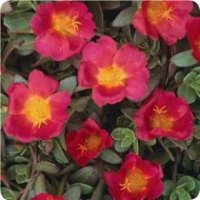
* Tropical Flowering Plants
* Plants for Baskets that can take the Heat and Sun
* Computer Problems (from G & G Computer Repair)
* Confederate Star Jasmine
* Helpful Websites & Additional Information
* Trailing Vinca, 4 inch pots - $1.29 each, $20 for a flat of 18
* Boston Ferns, 10 inch Hanging Basket - $11.99 each, 5 or more $10.99 each
* Azaleas, 1 gallon - $3.49 each, 10 or more for $2.99 each (Very nice & full plants)
* A very few Camellia japonicas left, 4 gallon - $14.99
* 4 inch Wave Petunias - $0.99 each (Colors: red & white)
TROPICAL FLOWERING PLANTS
Need a taller blooming plant for a special place in your garden? And you want it to bloom all summer but you don't want a rose? Try one of the following plants.
HIBISCUS

Hibiscus rosa sinensis, also known as Chinese Hibiscus is an evergreen shrub that is a very popular plant for our part of the country since it will continue to bloom as long as it is warm enough for it to grow.
Chinese Hibiscus blooms are very large and very showy. The individual blooms last for only one day but a plant that is growing well will produce many new ones each day. They come in many colors and forms; including red, yellow, pink, and in single blooms and double blooms. There is also one with attractive variegated leaves and red blooms.
Hibiscus are relatively easy to grow requiring part to full sun and regular light fertilizing. Allow the plant to dry a bit between watering, but not to the point of wilting which can make the flower buds drop.
Hibiscus are susceptible to a few insects including white flies and aphids which can be controlled with common insecticides.
ALLAMANDA

Allamanda cathartica, also known as Golden Trumpet is another tropical plant with showy flowers that deserves your consideration. Allamanda produces a steady profusion of 3 to 4 inch yellow trumpet shaped blooms all summer long, with the added benefit that once established it will be very drought tolerant also.
Allamandas are considered sprawling viney bushes that grow rather fast once the temperatures rise in the late spring and summer. If you plant an Allamanda it is a good idea to give it some support either with stakes or a trellis of some sort.
Allamanda is a relatively carefree plant that is bothered by few, if any, insects. The main thing to avoid is overwatering. Be sure to allow the soil to dry a bit between watering to avoid root rot.
MANDEVILLEA

Mandevillea amabilis 'Alice Du Pont' is the reigning queen of tropical vines with its lacy runners and huge pink flowers. This fantastic plant blooms all summer producing icey pink trumpet shaped blooms with a slightly darker pink throat. Train this fast grower on a trellis or up a column in a mostly sunny location.
The main insect problem for Mandevillea seems to be mealy bugs. Another nurseryman once told me that a mealy bug would crawl on its belly for miles to get to a Mandevillea. That's possibly just a bit of an exaggeration, but also watch for an occasional white fly.
Unfortunately the downside of all of these plants is that if left unprotected or uncovered in the winter they can be damaged or killed when temperatures fall below freezing. However the upside is that they will provide quite a bit of dazzling color for a long period of time. In addition these plants can be sucessfully grown in a container that you can bring in during subfreezing spells in the winter. If you plan to do that simply cut the plant back severly for the winter. Just leave a few leaves and reduce watering.
PRINCESS FLOWER

Princess Flower or Tibochina urvilleana is not quite as tender as the above plants and if planted in the ground can usually make it through a normal winter here in our area. At worst, the plant will freeze to the ground and return from the roots similar to Lantana. Princess Flower produces a two to three inch royal purple bloom in profusion during the warm (and hot) months.
Princess Flower is also sometimes called Glory Bush since it is so easy to grow if you have fertile well drained soil. If you can grow a hibiscus or a knock-out rose you can easily grow a Princess Flower since it has very few, if any, pest problems and few disease problems unless you keep the soil too soggy. Allow the soil to dry a bit between waterings. Even if you have a few yellow leaves that's better than root rot, don't you think?
Princess Flower can get larger than most of the other plants listed with the exception of the Allamanda so a light pruning every now and then won't hurt it a bit.
Try one of these showy plants in your garden. You, as well as the hummingbirds, will love the fabulous blooms that appear all late spring, summer, and fall. Oh, it doesn't hurt a bit to mulch these plants after planting to minimize weeds and to hold moisture and also so the ground below the plants doesn't look like a moonscape. Cheers!
PLANTS FOR BASKETS AND POTS THAT CAN TAKE THE HEAT AND SUN
You bought a beautiful hanging basket in early March however by the end of April it grew so large that you couldn't keep it watered. Or you planted your own basket with a plant you "know" can take the heat but then you almost have to stand by it with the water hose when hot weather comes. Sound familiar?
Now everyone knows Bougainvillea can take the heat and you really shouldn't need to water it more than once a day. But for some reason you just want something different. No problemo!
PURSLANE (Portulaca oleracea)

Enter Purslane. It's a close relation to Portulaca, commonly called Moss Rose. But Purslane has a lower growing, more trailing habit than common Portulaca. Plus it can take the heat like a desert trooper. Purslane comes in Red, Yellow, Pink, single bloom and also a double yellow and red flowering form. It is easy to grow and doesn't require you to station yourself next to the basket with a hose or a watering can. Once a day watering is all it needs, even in the hottest weather. Sometimes every other day!
It's not necessary (and it's probably counter-productive) to fertilize Purslane every time you water it. Just give it enough fertilizer to grow well - once a week with a good 20-10-20 soluable liquid or Miracle Gro will do - and it will reward you with tons of blooms all summer long. The blooms do tend to close at night so this is not a good one for viewing at night. But you will have plenty of open flowers the next morning.
If your Portulaca is growing in a peat based mix allow the soil to become somewhat dry then water well until the water comes out of the bottom of the basket. In other words; soak it good. That should hold the plant until the following day, no matter how hot it gets or how big the plant gets.
TRAILING VINCA (Catharanthus roseus)

|
Portulaca doesn't turn you on? Then try Trailing Vinca. Trailing Vinca is a relatively new plant introduction. (Just in the last five years or so.) It comes in Red, White, Pink, Purple, and bi-colors, all blooms are single. It is a spreading and cascading form of the common Vinca that you have always grown in flower beds in hot and sunny areas, especially in areas where you couldn't quite get the hose to without some trouble. Forget to water your Vinca and its wilting? No problem, just streach your hoss to its limit and soak the bed and the wilted plants revive and look just as good as they did before.
Trailing Vinca is just as tough in pots and baskets as common upright Vinca or Periwinkle is in the ground.
When the daytime temperatures stay over eighty degrees and the nightime temperatures stay over sixty degrees Trailing Vinca grows very well. One plant will fill a standard ten inch hanging basket and two or three plants will fill it faster. The hotter it gets the faster it will grow!
When the plants starts to bloom it doesn't quit. The flowers keep coming all summer long and at times can completely cover the leaves. How's that for flower power?
Water and care for your Trailing Vinca in about the same manner as described above for Purslane. When the plant is dry soak it well and then let it dry out. A bit of wilting won't hurt it a bit and a good watering will bring it back quickly. For best flower production don't let the plant dry out too much but on the other hand don't keep it soggy. Give it water when it's thirsty (when the pot is light if grown in peat based mix.) and it will reward you with tons of flowers.
(and how to avoid them)

|
Serving the Springfield and Ponchatoula Area G & G Computer Repair 12152 Hwy 22, Ponchatoula, LA 70454 Call 985-222-5359 |

|
Problems with computers, known commonly as PCs come in two distinct types; hardware and software.
HARDWARE PROBLEMS
Even brand new PCs can develop hardware problems. Thankfully all new computers usually come with at least a one year service warranty that will take care of faulty parts and components. But since computers can last much longer than one year what happens when the warranty runs out? And should we spring for extra to purchase an extended warranty? The answer to the first question is that we pay for any repairs out of our pocket after the first year. Ominous!
But wait! Most PC components that are faulty to begin with will invariably fail shortly after the PC is run for a while; almost certainly within the first year. So don't spend extra money for any extra warranties unless the extra warranty cost is less than three percent of the total cost of the PC. That usually means if you have purchased a very expensive system it is probably a good idea to get an extended warranty for it. But if you got a relatively inexpensive computer an extended warranty is not usually necessary. You were trying to save money in the first place, right?
If your PC and the components in it have run well for a year they will most likely continue to run for quite a while barring accidents and/or breakage. For example, if you drop your laptop you can be sure it will need some repairs if not complete replacement unless you are very lucky.
You can make your PC last longer free of hardware problems by simply keeping it clean both outside and inside. Invest in a can of compressed air (for electronic devices) and blow the dust out of your keyboard and out of the inside of your PC. Open your PC at least once a year (after unplugging it) and blow the dust bunnies out. For a laptop just open everything you can (without using tools), expecially the battery compartment (two or three times a year) and blow it out. Especially check the air vents to be sure they are free of dust and obstructions and be sure the vent fan is working and clean.
If you do the above on a regular basis your PC will last much longer than it would have without it. WARNING: When your PC's case is open don't touch any of the internal components with your bare hands. The danger of shock is low - but not nonexistant - if you unplug your system. However the static electricity in your body is plenty enough to damage delicate electronic components.
SOFTWARE PROBLEMS
For PCs of any age software problems can crop up. The worst problems come from Adware, Spyware and PC viruses from the internet. Be sure you have a good anti-virus program and check to be sure it is updated or that it is updating itself on a regular basis. If you have read any of my articles on anti-virus software you know that I advocate free software. There are at least two or three excellent free antivirus programs available. Go to CNET's Download.com to choose one. If you feel you must pay for a top-of-the-line anti-virus program choose Norton's top-rated Anti-virus from Symantec and be sure to keep the subscription paid up.
There is a nifty free anti-virus tool called Malwarebytes available also from Download.com that you can use to rid yourself of most common adware, spyware and quite a few virus files. Download it, install and update it and then run it when you suspect a virus infection. There is a also paid version but the free one works quite well.
All software problems and errors can be overcome and recovered from if you keep a backup of your data; even if it is necessary to re-install your entire operating system (Windows, or MacOS). So my advice is to invest in a good quality USB external hardrive to keep a backup of your entire system on. Make your backups periodically; once a week, month, etc. But make it!
If you feel lucky and decide you don't need an external drive for backup and you have internet access you can get a free Dropbox (2GB), iCloud (5 GB), or Skydrive (25 GB total or 5 GB synched) account to securely save your regularly used and frequently updated files to that synched folder. At least this way if your PC crashes you can, at least, recover your most important files.
If you have no backups at all you risk losing all of your irreplacable data if your hard drive crashes or your PC develops a serious software problem requiring an operating system re-installation.
Even if your main hard drive crashes and must be replaced you can still recover everything if you have a good backup.
Extend your hard drive's life by using Windows tools to check your disk at least once a year or more often if you use your PC a lot. Hit the Start button, then choose Computer, then right-click the Hard Drive (C) and choose Properties. Choose the Tools tab from the dialog box. Here you can check your hard drive and fix any disk errors that may have cropped up. Errors will be repaired when you restart your PC.
In the same dialog box you can also defragment your disk if necessary. Every so often - especially on older PCs - you may want to check to see if files on your hard drive have been fragmented into different sectors of the drive causing your disk to spin excessively while searching for files or simply opening a large file. If the disk is fragmented significantly the defragmenting process may take a while to complete.
Since your hard drive's platter spins at the rate of either 5400 or 7200 RPM anything you can do to reduce the extra spinning will extend its life.
Happy computing!
CONFETERATE STAR JASMINE

Need a vine that is cold hardy, grows quickly to cover an arbor or trellis and has wonderfully fragrant blossoms? Try Confederate Star Jasmine. Also known as simply Star Jasmine.
Star Jasmine is a great vine that may very well be almost ideal for our part of the country.
This is not a plant to get if you hate to prune. But if you don't mind sharpening your shears and giving this plant a wack once in a while you can end up with a beautiful full plant that will cover a very large area whether it's on a fence or an arbor. It provides a quick growing privacy screen on a chain link fence.
Give it a try!
Helpful Websites
LSU Agriculture Center - http://www.lsuagcenter.com/en/lawn_garden/
New! Horticulture Hints - From LSU Ag Center. This popular publication was once distributed in printed form from the County Agents but now is available only as a PDF directly from the LSU Ag Center Site.
In Louisiana -Find an LSU Ag Extension County Agent Near You
American Rose Society - Need some authoritative information on roses or want to contact fellow rosarians?
Azalea Society of America - Find out more about this highly divergent class of popular flowering shrubs.
Additional Information
Didn't like it? If you got this newsletter by mistake and don't want it or if you asked for it and are disappointed - we hope not - you may simply reply to this newsletter email with one word - UNSUBSCRIBE. That's it. We will take you off of our list immediately.
Liked it? However, if you liked it and wish to compliment, criticize or suggest, please feel free to do so. It's just as easy as unsubscribing. Just reply to this email with your helpful comments.
Have a request? Want us to get a particular plant variety for you for the fall, winter, or spring? If you let us know ahead of time and it's available we'll be certain to get just what you want.
Do you have a friend that you know would like our newsletter? Simply tell them to send an email to gmarmillion@bellsouth.net to request it and we'll send it right out to them.
Thank You,
Chris and Gary Marmillion

|
Green Thumb Nursery 12188 Highway 22 Ponchatoula, LA 70454 225-294-5089 greenthumbnsy.com |

|
